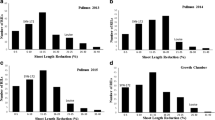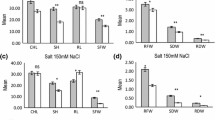Abstract
Submergence stress is a widespread problem in rice-growing environments where drainage is impeded. A few cultivars can tolerate more than 10 days of submergence, but the genes conferring this tolerance have not been identified. We used randon-amplified polymorphic DNA (RAPD) and restriction fragment length polymorphism (RFLP) markers to map submergence tolerance in 169 F2 plants and the resulting F3 families of a cross between a tolerant indica rice line, IR40931-26, and a susceptible japonica line, PI543851. IR40931-26 inherited strong submergence tolerance from the unimproved cultivar FR13A. Eight-day old F3 seedlings were submerged for 14–16 days in 55-cm deep tanks, and tolerance was scored after 7 days recovery on a scale of 1 (tolerant) to 9 (susceptible). The tolerant and susceptible parents scored 1.5 and 8.4, respectively, and the F3 means ranged from 1.6 to 8.9. Two bulks were formed with DNA from F2 plants corresponding to the nine most tolerant and the nine most susceptible F3 families. Of 624 RAPD primers used to screen the bulks, five produced bands associated with either tolerance or susceptibility. These markers were mapped to a region of chromosome 9 by linkage to RFLP markers. A submergence tolerance quantitative trait locus (QTL), here designatedSub1, was located ca. 4 cM from the RFLP marker C1232 and accounted for 69% of the phenotypic variance for the trait.
Similar content being viewed by others
References
Causse MA, Fulton TM, Cho YG, Ahn SN, Chunwongse J, Wu KS, Xiao JH, Yu ZH, Ronald PC, Harrington SE, Second G, McCouch SR, Tanksley SD: Saturated molecular map of the rice genome based on an interspecific backcross population. Genetics 138: 1251–1274 (1994).
Emes MJ, Wilkins CP, Smith PA, Kapkanchanakul K, Hawker K, Charlton WA, Cutter EG: Starch utilization by deepwater rices during submergence. In: Proceedings of the 1987 International Deepwater Rice Workshop, pp. 319–326. International Rice Research Institute, Los Baños, Philippines (1988).
Haque QA, HilleRisLambers D, Tepora NM, delaCruz QD: Inheritance of submergence tolerance in rice. Euphytica 41: 247–251 (1989).
HilleRisLambers D, Gomosta AR, Kupkanchanakul T: Screening for submergence tolerance. In: Progress in Rainfed Lowland Rice, pp. 177–190. International Rice Research Institute, Los Baños, Philippines (1986).
HilleRisLambers D, Vergara BS: Summary results of an international collaboration on screening methods for flood tolerance. In: Proceedings of the 1981 International Deepwater Rice Workshop, pp. 347–353. International Rice Research Institute, Los Baños, Philippines (1982).
IRRI: Program report for 1994. International Rice Research Institute, Los Baños, Philippines (1995).
Ishikawa R, Morishima H: Linkage analysis for four isozyme loci,Adh-1, Acp-1, Pox-2 andPgd-2. Rice Genet Newsl 6: 109–112 (1989).
Karin S, Vergara BS, Mazaredo AM: Anatomical and morphological studies of rice varieties tolerant of and susceptible to complete submergence at the seedling stage. In: Proceedings of the 1981 International Deepwater Rice Workshop, pp. 287–291. International Rice Research Institute, Los Baños, Philippines (1982).
Kinoshita T: Current linkage maps. Rice Genet Newsl 10: 17–32 (1993).
Kurata N, Nagamura Y, Yamamoto K, Harushima Y, Sue N, Wu J, Antonio BA, Shomura A, Shimizu T, Lin SY, Inoue T, Fukuda A, Shimano T, Kuboki Y, Toyama T, Miyamoto Y, Kirihara T, Hayasaka K, Miyao A, Monna L, Zhong HS, Tamura Y, Wang ZX, Momma T, Umehara Y, Yano M, Sasaki T, Minobe Y: A 300 kilobase interval genetic map of rice including 883 expressed sequences. Nature Genet 8: 365–372 (1994).
Lander ES, Botstein D: Mapping Mendelian factors underlying quantitative traits using RFLP linkage maps. Genetics 121: 185–199 (1989).
Lander ES, Green P, Abrahamson J, Barlow A, Daly M, Lincoln SE, Newburg L: Mapmaker: an interactive computer package for constructing primary genetic linkage maps of experimental and natural populations. Genomics 1: 174–181 (1987).
Lincoln S, Daly M, Lander E: Constructing genetic maps with MAPMAKER/EXP 3.0 Whitehead Institute Technical Report. 3rd ed. (1992).
Lincoln S, Daly M, Lander E: Mapping genes controlling quantitative traits with MAPMAKER/QTL 1.1 Whitehead Institute Technical Report, 2nd ed. (1992).
Mackill DJ: Rainfed lowland rice improvement in South and Southeast Asia: Results of a survey. In: Progress in Rainfed Lowland Rice, pp. 115–144. International Rice Research Institute, Los Baños, Philippines (1986).
Mackill DJ: Classifying japonica rice cultivars with RAPD markers. Crop Sci 35: 889–894 (1995).
Mackill DJ, Amante MM, Vergara BS, Sarkarung S: Improved semidwarf rice lines with tolerance to submergence of seedlings. Crop Sci 33: 749–753 (1993).
Mackill DJ, Coffman WR, Garrity DP: Rainfed lowland rice improvement. International Rice Research Institute, Los Baños, Philippines (1996).
McCouch SR, Kochert G, Yu ZH, Wang ZY, Khush GS, Coffman WR, Tanksley SD: Molecular mapping of rice chromosomes. Theor Appl Genet 76: 815–829 (1988).
Michelmore RW, Paran I, Kesseli RV: Identification of markers linked to disease-resistance genes by bulked segregant analysis: a rapid method to detect markers in specific genomic regions by using segregating populations. Proc Natl Acad Sci USA 88: 9828–9832 (1991).
Mohanty HK, Chaudhary RC: Breeding for submergence tolerance in rice in India. In Progress in Rainfed Lowland Rice, pp. 191–200. International Rice Research Institute, Los Baños, Philippines (1986).
Mohanty HK, Khush GS: Diallel analysis of submergence tolerance in rice,Oryza sativa L. Theor Appl Genet 70: 467–473 (1985).
Mohanty HK, Suprihatno B, Khush GS, Coffman WR, Vergara BS: Inheritance of submergence tolerance in deepwater rice. In: Proceedings of the 1981 International Deepwater Rice Workshop., pp. 121–134. International Rice Research Institute, Los Baños, Philippines (1982).
Palada MC, Vergara BS: Environmental effects on the resistance of rice seedlings to complete submergence. Crop Sci 12: 209–212 (1972).
Paterson AH, Lander ES, Hewitt JD, Peterson S, Lincoln SE, Tanksley SD: Resolution of quantitative traits into Mendelian factors by using a complete linkage map of restriction fragment length polymorphisms. Nature 335: 721–726 (1988).
Ranjhan S, Glaszmann JC, Ramirez DA, Khush GS: Chromosomal localization of four isozyme loci by trisomic analysis in rice (Oryza sativa L.). Theor Appl Genet 75: 541–545 (1988).
SAS Institute Inc.: SAS/STAT® User's Guide, Version 6, Fourth Ed., Vol. 1. SAS Institute, Cary, NC (1989).
Setter TL: Important physiological mechanisms of submergence tolerance in rice. In: Kuo GC (ed) Adaptation of food crops to temperature and water stress. Proceedings International Symposium Taiwan, 13–18 August 1992, pp. 220–230. Asian Vegetable Research and Development Center, Taiwan (1993).
Sinha MM, Saran S: Inheritance of submergence tolerance in lowland rice. Oryza 25: 351–354 (1988).
Smith PA, Kupkanchanakul K, Emes MJ, Cutter EG: Changes in fluorescence and photosynthesis during submergence of deepwater rice. In: 1987 International Deepwater Rice Workshop, pp. 327–335. International Rice Research Institute, Los Baños, Philippines (1988).
Suprihatno B, Coffman WR: Inheritance of submergence tolerance in rice (Oryza sativa L.). SABRAO J 13: 98–108 (1981).
Tingey SV, delTufo JP: Genetic analysis with random amplified polymorphic DNA markers. Plant Physiol 101: 349–352 (1993).
Vergara BS, Mazaredo A: Screening for resistance to submergence under greenhouse conditions. In: Proceedings of the International Seminar on Deepwater Rice, August 1974, pp. 67–70. Bangladesh Rice Research Institute, Dacca (1975).
Williams JF, Roberts SR, Hill JE, Scardaci SC, Tibbits G: Managing water for weed control in rice. Calif Agric 44(5): 6–10 (1990).
Williams JGK, Kubelik AR, Livak KJ, Rafalski JA, Tingey SV: DNA polymorphism amplified by arbitrary primers are useful as genetic markers. Nucl Acids Res 18: 6531–6535 (1990).
Yanagihara S, McCouch SR, Ishikawa K, Ogi Y, Maruyama K, Ikehashi H: Molecular analysis of the inheritance of theS-5 locus, conferring wide compatibility in Indica/Japonica hybrids of rice (O. sativa L.). Theor Appl Genet 90: 182–188 (1995).
Author information
Authors and Affiliations
Rights and permissions
About this article
Cite this article
Xu, K., Mackill, D.J. A major locus for submergence tolerance mapped on rice chromosome 9. Mol Breeding 2, 219–224 (1996). https://doi.org/10.1007/BF00564199
Received:
Accepted:
Issue Date:
DOI: https://doi.org/10.1007/BF00564199




